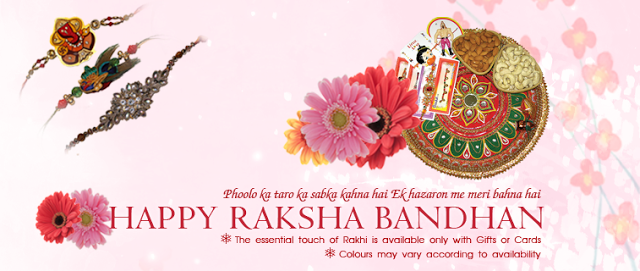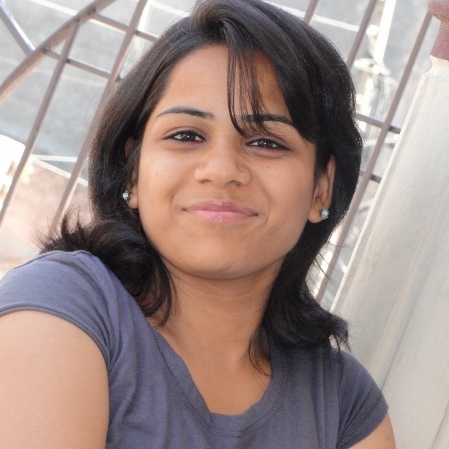
Last Updated on
Today is the day of Rakhi Festival (2 Aug 2012), so here I’m wish
to all my friends and viewers….
to all my friends and viewers….
HAPPY RAKSHA BANDHAN
Holi is colourful,
Diwali is lightful & brightful,
But Rakhi has made our relationship powerful….
The Meaning of Raksha Bandhan
Relationships are the essence of any festivity and
it holds true for any Indian festival. Each occasion brings the family together
which calls for a celebration. Raksha Bandhan is a celebration of one such relation
– that of a brother and a sister. This relationship is nowhere as celebrated as
in India. Raksha Bandhan is a festival which celebrates the bond of affection
between brothers and sisters. It is a day when siblings pray for each other’s’ wellbeing
and wish for each other’s’ happiness and goodwill.
The name ‘Raksha
Bandhan’ suggests ‘a bond of protection’. On this auspicious day, brothers make
a promise to their sisters to protect them from all harms and troubles and the
sisters pray to God to protect their brother from all evil. The festival falls
on the Shravan Purnima which comes generally in the month of August. Sisters
tie the silk thread called Rakhi on their brother’s wrist and pray for their well-being
and brothers promise to take care of their sisters.
Relationships are the essence of any festivity and
it holds true for any Indian festival. Each occasion brings the family together
which calls for a celebration. Raksha Bandhan is a celebration of one such relation
– that of a brother and a sister. This relationship is nowhere as celebrated as
in India. Raksha Bandhan is a festival which celebrates the bond of affection
between brothers and sisters. It is a day when siblings pray for each other’s’ wellbeing
and wish for each other’s’ happiness and goodwill.
The name ‘Raksha
Bandhan’ suggests ‘a bond of protection’. On this auspicious day, brothers make
a promise to their sisters to protect them from all harms and troubles and the
sisters pray to God to protect their brother from all evil. The festival falls
on the Shravan Purnima which comes generally in the month of August. Sisters
tie the silk thread called Rakhi on their brother’s wrist and pray for their well-being
and brothers promise to take care of their sisters.
Legends of
Raksha Bhandan
Raksha Bhandan
Origin
The Shravana or the monsoon month
carries all hues and shades of nature and emotions. Religiously speaking
Shravan is a pious month and full moon of this all-important month is
considered to be a very holy day. It is celebrated in different ways for
different reasons almost throughout the country. For the siblings it is the
eternal tie of love, for Brahmins the day to take the pledge of Brahmanik rites
and for those who depend on sea and monsoon, it is the beginning of the
new season.
Yama and the Yamuna
It’s said that the Raksha Bandhan was a
ritual followed by Lord Yama (the Lord of Death) and his sister Yamuna. Yamuna
tied rakhi to Yama and bestowed immortality. Yama was so moved by the serenity
of the occasion that he declared that whoever gets a rakhi tied from
his sister and promised her protection will become immortal.
In the Epics
Raksha Bandhan finds a mention in
Mahabharata when Lord Krishna advised Yudhishthir to perform theceremony to
protect himself and the army from the dangers of the war. It is said
that Kunti, the mother of the Pandavas tied rakhi to her grandson Abhimanyu and
Draupadi to lord Krishna.
The Shravana or the monsoon month
carries all hues and shades of nature and emotions. Religiously speaking
Shravan is a pious month and full moon of this all-important month is
considered to be a very holy day. It is celebrated in different ways for
different reasons almost throughout the country. For the siblings it is the
eternal tie of love, for Brahmins the day to take the pledge of Brahmanik rites
and for those who depend on sea and monsoon, it is the beginning of the
new season.
Yama and the Yamuna
It’s said that the Raksha Bandhan was a
ritual followed by Lord Yama (the Lord of Death) and his sister Yamuna. Yamuna
tied rakhi to Yama and bestowed immortality. Yama was so moved by the serenity
of the occasion that he declared that whoever gets a rakhi tied from
his sister and promised her protection will become immortal.
In the Epics
Raksha Bandhan finds a mention in
Mahabharata when Lord Krishna advised Yudhishthir to perform theceremony to
protect himself and the army from the dangers of the war. It is said
that Kunti, the mother of the Pandavas tied rakhi to her grandson Abhimanyu and
Draupadi to lord Krishna.
Regional Celebrations
Rakhi which is an
important festival in India is observed differently in various parts of the
country. Though it is a festival celebrated largely in North and Western India,
it holds special significance in
other parts of the country as well.
Nariyal Purnima:
Coconut Day festival or Narali Purnima is celebrated each year with loads of
fun by the people of Maharashtra namely the fishermen on the full moon day in
the month of Shravan. Thefestival coincides with Rakhi Purnima and is
celebrated mostly by the fishermen.
Kajari
Purnima:
Kajari Purnima is celebrated on the same day as Rakhi mostly by the people of
Madhya Pradesh, Chattisgarh and parts of Uttar Pradesh. The rituals of this day
are performed by women who are blessed with a son.
Rakhi which is an
important festival in India is observed differently in various parts of the
country. Though it is a festival celebrated largely in North and Western India,
it holds special significance in
other parts of the country as well.
Nariyal Purnima:
Coconut Day festival or Narali Purnima is celebrated each year with loads of
fun by the people of Maharashtra namely the fishermen on the full moon day in
the month of Shravan. Thefestival coincides with Rakhi Purnima and is
celebrated mostly by the fishermen.
Kajari
Purnima:
Kajari Purnima is celebrated on the same day as Rakhi mostly by the people of
Madhya Pradesh, Chattisgarh and parts of Uttar Pradesh. The rituals of this day
are performed by women who are blessed with a son.
Avani Avittam / Upakarmam: Oakhi Purnima is known as Avani Avittam in southern
parts of India i.e.
in Kerala, Andhra Pradesh, and Tamil Nadu and even in parts of Orissa. It is an
important day for the Brahmins as they change their holy threads on this day.
Brahmins take a holy dip and wear the holy thread called Yajnopavit or Janeyu.
The first step is the ‘prayashchita’, which is performed as an atonement of all
the sins. Mantras are read out at both times when the thread is worn and when
it is taken out to be replaced with a new one.
parts of India i.e.
in Kerala, Andhra Pradesh, and Tamil Nadu and even in parts of Orissa. It is an
important day for the Brahmins as they change their holy threads on this day.
Brahmins take a holy dip and wear the holy thread called Yajnopavit or Janeyu.
The first step is the ‘prayashchita’, which is performed as an atonement of all
the sins. Mantras are read out at both times when the thread is worn and when
it is taken out to be replaced with a new one.
Pavitropana:
This is mostly celebrated by the people of Gujarat who are devotees of Lord
Shiva. On this day water is offered to the Lord and people pray and ask for
forgiveness.
This is mostly celebrated by the people of Gujarat who are devotees of Lord
Shiva. On this day water is offered to the Lord and people pray and ask for
forgiveness.
Rakhi Thali Decoration
Traditionally the Rakhi thali is the same as the thali for the pooja of
the deities. The Rakhi Thali contains a diya, roli or tika, rice, sandalwood,
incense sticks. In the Raksha bandhan thali, the rakhis are kept along with the
moli.
Method of performing the Puja
Sister applies tilak to the brother’s
forehead and then place some rice or akshat on his forehead. She ties rakhi on
the right wrist of the brother. A coconut is given to the brother and the
sister gives some sweet to him. According to his wish, the brother gives a gift
or cash to her sister. Then sister applies tilak to bhabhi. On the bangles
of the left hand, sister ties the Lumba, and then gives to gola and sweets
to her. The Bhabhi gives some gifts or cash to the sister. Then the
sister applies tilak to the nephews and nieces and ties to kid’s funky
rakhi’s, gives Sweets or chocolates and some gifts are given to kids.
Soan (Shagun) Maandana/ Wall religious
sticker
Soan Maandana denotes making auspicious symbols. Making auspicious symbols
outside the door on the day of Raksha Bandhan brings well-being. The day of Rakhi,
we smear chuna on the both side and make Soan (shagun) with red clay (geru). These
designs could be either a swastik, Ram Ram, Radhe Krishna or any religious
sign. On the day of Purnima, sprinkle this with water, roli and chawal and we
stick a piece of moli thread with little laddu or food which we prepared on the
same day. These days we made Soan handmade as a sticker.
the deities. The Rakhi Thali contains a diya, roli or tika, rice, sandalwood,
incense sticks. In the Raksha bandhan thali, the rakhis are kept along with the
moli.
Method of performing the Puja
Sister applies tilak to the brother’s
forehead and then place some rice or akshat on his forehead. She ties rakhi on
the right wrist of the brother. A coconut is given to the brother and the
sister gives some sweet to him. According to his wish, the brother gives a gift
or cash to her sister. Then sister applies tilak to bhabhi. On the bangles
of the left hand, sister ties the Lumba, and then gives to gola and sweets
to her. The Bhabhi gives some gifts or cash to the sister. Then the
sister applies tilak to the nephews and nieces and ties to kid’s funky
rakhi’s, gives Sweets or chocolates and some gifts are given to kids.
Soan (Shagun) Maandana/ Wall religious
sticker
Soan Maandana denotes making auspicious symbols. Making auspicious symbols
outside the door on the day of Raksha Bandhan brings well-being. The day of Rakhi,
we smear chuna on the both side and make Soan (shagun) with red clay (geru). These
designs could be either a swastik, Ram Ram, Radhe Krishna or any religious
sign. On the day of Purnima, sprinkle this with water, roli and chawal and we
stick a piece of moli thread with little laddu or food which we prepared on the
same day. These days we made Soan handmade as a sticker.
For more detail On Soan sample
Video’s On Rakhi Fest

Simply Tadka is one place where I can show my passion for cooking and photography. My blog features easy and quick vegetarian recipes that don’t demand much time and effort. I loves experimenting and substitutes some of the ingredients that are not easily available in the kitchen. For more details Check here












Happy Raksha Bandhan 🙂
Such a detail and lovely post. Happy Raksha Bandhan.
excellent…thanks for sharing..:P
Tasty Appetite
nice
Hi Preeti ,
I'm Punitha of
http://www.southindiafoodrecipes.blogspot.in
New to your lovely space:)
Nice feel , Keep on Dear…
At your free time do visit my blog Preeti…
I love this Raksha Bandhan Pic Video, Thanks so much for this collection.
There is so many festival in india but Rakhi festival have own value. i many time heard Rakhi to India
Rakhi Gifts to India